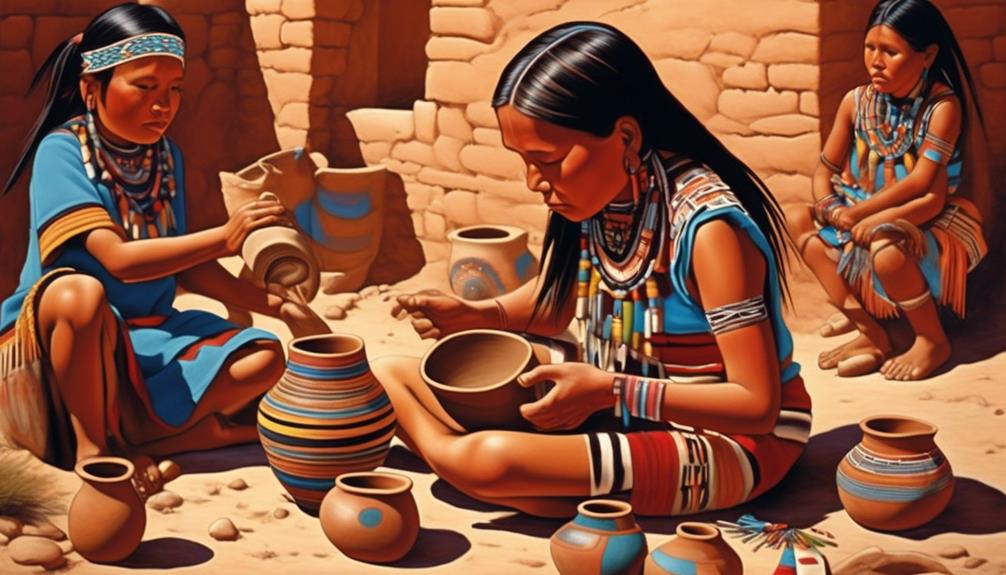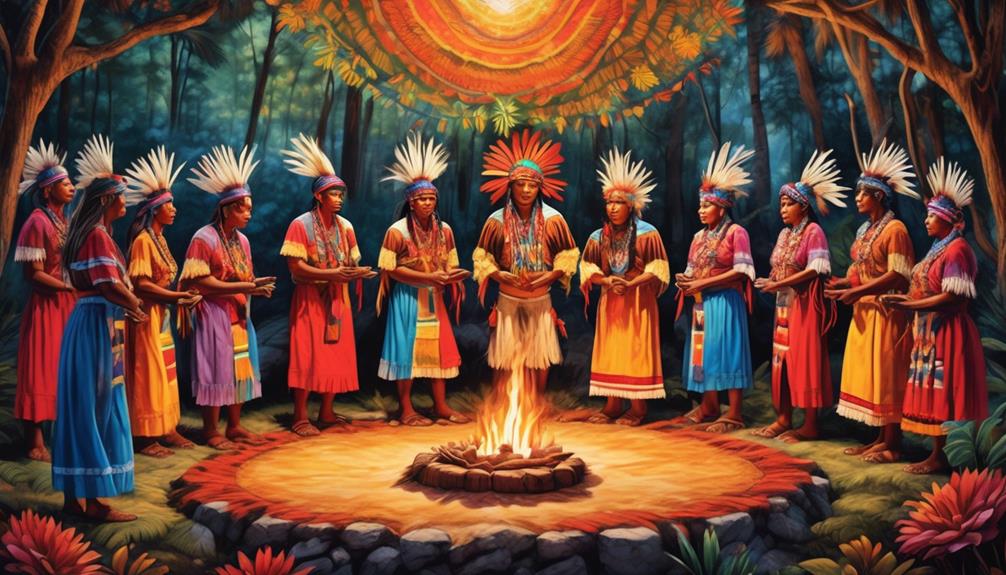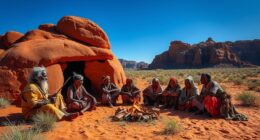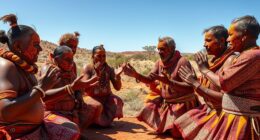What sets jazz apart as a distinct American music genre?
The answer lies in the intricate blend of cultural influences, rhythmic complexities, and improvisational nature that define jazz.
As we explore the origins, evolution, and impact of jazz, we will uncover the distinct qualities that have shaped it into a genre that is not only cherished in the United States but also revered worldwide.
Key Takeaways
- Jazz originated from a fusion of African and European musical traditions in the southern United States, particularly in New Orleans.
- The cultural influences on jazz include African rhythms, European harmonies, and the absorption of influences from various ethnic and musical traditions.
- Improvisation is a defining characteristic of jazz, with spontaneous creation of melodies and harmonies.
- The evolution of jazz in the U.S. has seen the emergence of jazz fusion, incorporating elements from rock, funk, R&B, and other styles, reflecting societal changes and the use of electronic instruments and digital technology.
Origins of Jazz
The origins of jazz can be traced back to the late 19th century, emerging from a blend of African and European musical traditions in the southern United States. The African roots of jazz are profound, with the music drawing heavily from West African musical practices, including rhythmic complexity, call-and-response patterns, and improvisation. The rhythmic vitality and syncopation evident in jazz find their origins in the traditional music of West Africa, where complex polyrhythms and cross-rhythms were integral to musical expression.
The New Orleans beginnings of jazz are also pivotal to its development, as the city served as a melting pot of cultures, where African, Caribbean, and European musical influences converged. New Orleans, with its diverse population and vibrant music scene, played a crucial role in shaping jazz. The city's rich cultural tapestry and the intermingling of different musical traditions provided fertile ground for the gestation of this new musical form. It was in New Orleans that jazz began to evolve, taking shape through the fusion of diverse musical influences and the innovative creativity of early jazz musicians.
Cultural Influences on Jazz

Influenced by a diverse array of cultural traditions, jazz music encompasses a rich tapestry of musical styles and expressions that have shaped its evolution over time. The cultural influences on jazz are profound, with various elements contributing to its unique identity.
- African rhythms: The rhythmic complexity and syncopation in jazz can be traced back to African musical traditions, particularly those from West Africa. The use of polyrhythms and intricate percussive elements reflects the influence of African rhythms on jazz.
- European harmonies: Jazz has been significantly influenced by European classical music, particularly in terms of harmonic structures. The incorporation of European harmonic principles into jazz compositions has led to the development of complex chord progressions and melodic arrangements.
- Cultural fusion: Jazz is characterized by its ability to blend and integrate diverse cultural elements. It has absorbed influences from various ethnic and musical traditions, resulting in a dynamic and ever-evolving improvisational style that reflects a fusion of cultural influences.
The interplay of African rhythms, European harmonies, and cultural fusion has contributed to the rich tapestry of jazz, shaping its distinctive sound and making it a truly indigenous musical form of the United States.
Musical Characteristics of Jazz
Drawing from a diverse array of musical traditions, jazz exhibits a unique set of characteristics that define its distinct sound and style. One of the most defining features of jazz is improvisation. This practice allows musicians to spontaneously create melodies and harmonies, giving each performance a sense of individuality and unpredictability. It's through improvisation that jazz musicians showcase their virtuosity and creativity, making each rendition of a piece a unique and unparalleled experience.
Another key characteristic of jazz is syncopation. This rhythmic technique involves emphasizing off-beat notes or accentuating beats that aren't typically stressed in other musical genres. Syncopation adds a layer of complexity and groove to jazz music, creating a sense of forward momentum and energy that's distinctive to the genre. It's this rhythmic dynamism that often compels listeners to move and dance to the music.
In essence, the musical characteristics of jazz, including improvisation and syncopation, contribute to its unparalleled allure and make it a truly unique and indigenous form of musical expression in the United States.
Evolution of Jazz in the U.S

Evolution of jazz in the U.S reflects the ongoing transformation and expansion of the genre, encompassing a rich tapestry of historical, social, and cultural developments. Jazz fusion, a genre that emerged in the late 1960s, has played a pivotal role in the evolution of jazz in the United States. It represents a fusion of jazz with elements of rock, funk, R&B, and other diverse musical styles, contributing to the genre's adaptability and relevance in contemporary music.
Moreover, jazz improvisation has been a central driving force in the evolution of jazz in the U.S. This spontaneous and creative element has allowed the genre to constantly reinvent itself, giving rise to new subgenres and pushing the boundaries of musical expression.
The evolution of jazz has also been deeply intertwined with societal changes, serving as a reflection of the shifting cultural landscape in the United States.
Furthermore, the incorporation of electronic instruments and digital technology has propelled the evolution of jazz, ushering in new sounds and production techniques. This integration has enabled jazz to remain at the forefront of innovation while retaining its core improvisational and experimental spirit.
Impact and Legacy of Jazz
How has jazz shaped and influenced the broader musical landscape, leaving a lasting legacy on both artists and audiences alike? Jazz's impact can be seen in its innovative approach to rhythm, harmony, and improvisation, which have influenced a wide array of musical genres. From the syncopated rhythms of swing to the modal harmonies of cool jazz, the genre's innovations have permeated popular music, inspiring artists across the spectrum.
The legacy of jazz is evident in the enduring influence it has had on subsequent generations of musicians. Jazz's emphasis on improvisation and individual expression has left an indelible mark on modern music, empowering artists to push the boundaries of creativity. Furthermore, the impact of jazz extends beyond the realm of music, influencing cultural and social movements, and serving as a vehicle for social change.
To further illustrate the impact and legacy of jazz, the table below highlights key areas where jazz has made a significant impression:
| Impact | Innovation |
|---|---|
| Musical Diversity | Improvisation |
| Cultural Fusion | Rhythmic |
| Artistic Freedom | Harmonic |
Frequently Asked Questions
What Are the Key Differences Between Jazz and Other Musical Forms, Such as Blues or Rock?
Key differences between jazz and other musical forms, such as blues or rock, lie in its emphasis on improvisation, complex harmonies, and syncopated rhythms. These elements contribute to its unique musical innovation and distinguish it from other genres.
Jazz's ability to blend diverse musical influences and its focus on individual expression set it apart. Its evolution through African American culture and its impact on global music make it a truly distinctive form.
How Has Jazz Influenced Other Genres of Music Outside of the United States?
Jazz's influence abroad has had a global impact, shaping various music genres worldwide. Its improvisational nature and complex harmonies have seeped into Latin American music, European classical compositions, and even Asian traditions.
This cross-pollination has enriched music globally, fostering innovative sounds and styles. Jazz's syncopated rhythms and expressive melodies have found resonance in diverse cultures, leaving an indelible mark on the musical landscape beyond the United States.
What Role Did Segregation and Racism Play in the Development of Jazz in the United States?
Segregation and racism heavily influenced jazz in the United States. These societal challenges led to a unique cultural fusion, inspiring improvisation as a form of musical expression.
The struggle against segregation and racism provided a backdrop for jazz musicians to channel their emotions and experiences into their music, creating a sound that resonates with the complexities of American history and identity.
How Has Technology, Such as Recording and Radio, Shaped the Evolution of Jazz?
Evolution of technology has significantly shaped jazz. Recording and radio allowed jazz to reach a wider audience, influencing international music scenes. This exposure facilitated cross-cultural exchange, enriching jazz with diverse influences.
Jazz's adaptability and innovation made it resonate globally. Its fusion of traditional and modern elements continues to captivate audiences.
The evolution of technology hasn't only preserved jazz's legacy but also propelled it to new heights of creativity and influence.
What Are the Main Challenges Facing the Preservation and Promotion of Jazz as a Uniquely American Art Form?
Preserving tradition in jazz is vital for honoring its rich history and cultural significance. However, promoting innovation is equally important to ensure its continued relevance and evolution.
The main challenges facing the preservation and promotion of jazz as a uniquely American art form include balancing tradition with innovation, fostering wider appreciation, and addressing the impact of commercialization on artistic integrity.
Balancing tradition with innovation requires finding a delicate equilibrium where the roots of jazz are respected and upheld, while also encouraging experimentation and pushing boundaries. This allows for the exploration of new sounds and ideas while staying true to the essence of the genre.
Fostering wider appreciation involves reaching out to new audiences and breaking down barriers that may prevent people from engaging with jazz. This can be achieved through educational initiatives, community outreach programs, and collaborations with other musical genres to demonstrate the versatility and accessibility of jazz.
Addressing the impact of commercialization on artistic integrity is crucial in preserving the authenticity and artistic value of jazz. Commercial interests can sometimes prioritize marketability over artistic excellence, leading to watered-down or diluted versions of the genre. Balancing financial considerations with artistic integrity is essential to ensure that jazz remains a true representation of its cultural heritage.
Conclusion
In conclusion, jazz is like a vibrant garden, rooted deeply in the rich soil of American culture and history, blooming with diverse musical influences and innovations.
It embodies the spirit of freedom and improvisation, constantly evolving and adapting to the changing world around it.
Jazz's unique qualities haven't only shaped American music, but also left a lasting impact on global musical traditions.
It stands as a testament to the creativity and resilience of the American people.









